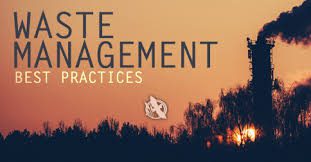Environmental management best practices refer to a set of strategies, principles, and actions aimed at effectively and sustainably managing and minimizing the environmental impacts of human activities.
Environmental management best practices are essential guidelines and strategies that help us protect our environment while meeting our developmental and industrial needs.
By following these practices, we can reduce harm to nature, conserve resources, and ensure a healthier and more sustainable future for all. These practices typically include:
1. Understanding Environmental Impact: Before starting any project or activity, it’s crucial to assess how it might affect the environment. This is called an Environmental Impact Assessment (EIA). By doing this, we can identify potential problems and find ways to avoid or minimize them.
2. Following the Rules: We have laws and rules in place to protect the environment. Following these regulations, whether they’re local, national, or international, is essential. It helps us avoid harmful actions and consequences.
3. Preventing Pollution: One of the best things we can do is stop pollution at its source. This means using cleaner technologies and finding ways to use fewer resources. Less pollution means a healthier environment for us and future generations.
4. Taking Care of Nature: Our planet is home to countless plants and animals. To protect them, we need to conserve natural habitats and biodiversity. This includes efforts like creating wildlife reserves and protecting endangered species.
5. Wise Resource Management: Resources like water, energy, and land are limited. We should use them wisely to make sure there’s enough for everyone. This means using water-saving appliances, adopting energy-efficient technologies, and avoiding wasteful land use.
6. Managing Waste: Waste can harm the environment if not handled properly. Recycling, reusing, and safely disposing of waste are crucial practices. They reduce the burden on landfills and help keep our surroundings clean.
7. Saving Energy: Using energy efficiently not only cuts costs but also reduces greenhouse gas emissions. Turn off lights when not needed, insulate homes, and consider using energy-efficient appliances and vehicles.
8. Greener Transportation: Choosing eco-friendly transportation options like walking, cycling, public transit, or electric vehicles can lower air pollution and decrease our carbon footprint.
9. Responsibility in Business: Businesses can make a big impact. Many have adopted Corporate Social Responsibility (CSR) policies that include environmental concerns. This can involve using sustainable materials, reducing waste, and supporting green initiatives.
10. Involving Everyone: Environmental responsibility isn’t just for governments and businesses. Everyone can play a part. Educating ourselves and raising awareness about environmental issues is a good start. Small changes in our daily lives, like reducing plastic use or planting trees, can make a big difference.
11. Listening to Others: When making decisions that affect the environment, it’s essential to involve and listen to the opinions of people who might be affected. This is called stakeholder engagement, and it ensures that everyone’s interests are considered.
12. Always Improving: Lastly, the world is always changing. New technologies and challenges arise. So, it’s crucial to review and improve our environmental practices regularly. This way, we can stay up-to-date and continue to protect our planet effectively.
Environmental management best practices are like a guidebook for taking care of our planet. By following these practices, we can ensure a cleaner, healthier, and more sustainable environment for ourselves and generations to come. Let’s work together to protect and cherish the beautiful world we call home.
Read Also: Strategies for Managing a Hazardous Waste Disposal Business
The Importance of Environmental Management Best Practices

Environmental management best practices are like a set of golden rules for safeguarding our environment. They are incredibly important because they help us preserve nature, save resources, and make our world a better place for everyone.
Below are the importance of environmental management best practices;
1. Protecting Our Health: When we follow environmental management best practices, we reduce pollution and harmful chemicals in the air, water, and soil. This means cleaner air to breathe, safer water to drink, and healthier food to eat. It’s all about keeping us and our families well.
2. Preserving Nature’s Beauty: Our planet is full of natural wonders like lush forests, clear lakes, and diverse wildlife. By taking care of our environment, we ensure these beautiful places and creatures thrive for generations to come. Imagine a world without the breathtaking sights of nature!
3. Saving Resources: Environmental management practices help us use resources like water, energy, and land wisely. When we waste less, there’s more to go around. Plus, it’s a way to make sure we leave something for our children and grandchildren.
4. Fighting Climate Change: The way we use energy and resources can either worsen or help combat climate change. Best practices, like using clean energy and reducing emissions, are vital in the fight against global warming. This means fewer extreme weather events and a more stable climate.
5. Economic Benefits: Many environmental practices also make good economic sense. Businesses that use resources efficiently save money. Clean technologies create jobs. So, protecting the environment can boost the economy and create opportunities.
6. Biodiversity Matters: Biodiversity, or the variety of plants and animals on Earth, is crucial. It keeps ecosystems balanced and provides us with food and medicines. Environmental management practices help us protect and preserve this diversity.
7. Responsible Businesses: Companies that adopt environmental management best practices are often seen as responsible and trustworthy. They attract more customers and partners, which can lead to growth and success.
8. Community Well-Being: Clean and green environments make for happier communities. Parks, clean waterways, and healthy ecosystems offer spaces for recreation and relaxation, improving our quality of life.
9. Sustainable Future: Environmental practices ensure that we meet our needs today without compromising the ability of future generations to meet their needs. It’s about thinking ahead and being responsible stewards of our planet.
10. Global Responsibility: Our world is interconnected. Actions in one place can affect people and nature on the other side of the globe. By following best practices, we contribute to global efforts to protect the environment and promote peace and cooperation.
Environmental management best practices are not just guidelines; they are the foundation of a better future. By following these practices, we can enjoy cleaner air, protect nature’s beauty, and ensure a sustainable world for ourselves and generations yet to come. It’s a responsibility we all share, and it’s our duty to make a positive impact.
Read Also: The Benefits of Landfill Monetization Business Ideas
Best Environmental Practices

Best Environmental Practices (BEPs) are a set of guidelines and strategies that individuals, businesses, and communities can adopt to minimize their environmental impact and promote sustainability. These practices play a vital role in conserving natural resources, reducing pollution, and ensuring a healthier planet for present and future generations.
1. Reduce, Reuse, Recycle (3Rs): The 3Rs are fundamental BEPs. Reduce consumption when possible, reuse items to extend their lifespan, and recycle materials to keep them out of landfills. It’s a simple but effective way to cut down on waste.
2. Energy Efficiency: Embracing energy-efficient technologies and habits, such as using LED lighting, turning off appliances when not in use, and upgrading insulation, not only reduces energy bills but also lowers greenhouse gas emissions.
3. Water Conservation: Conserving water through practices like fixing leaks, using low-flow fixtures, and harvesting rainwater helps preserve this precious resource, especially in areas prone to drought.
4. Sustainable Transportation: Opting for eco-friendly transportation methods like carpooling, biking, walking, or using public transit reduces air pollution and decreases our carbon footprint.
5. Renewable Energy Sources: Transitioning to renewable energy sources like solar, wind, and hydroelectric power contributes to cleaner energy production and reduces dependence on fossil fuels.
6. Pollution Prevention: Preventing pollution at the source by adopting cleaner production methods and using eco-friendly products helps protect air, water, and soil quality.
7. Biodiversity Preservation: Protecting natural habitats, planting native species, and avoiding the use of harmful pesticides and herbicides supports biodiversity and the delicate balance of ecosystems.
8. Waste Reduction and Management: Implementing waste reduction practices and proper disposal methods, including composting organic waste, minimizes the environmental impact of waste generation.
9. Corporate Responsibility: Businesses can adopt BEPs by incorporating environmental sustainability into their operations, supply chains, and products. This enhances their reputation and contributes to a greener economy.
10. Education and Awareness: Raising awareness and educating individuals and communities about environmental issues and BEPs is crucial. Informed citizens are more likely to make eco-conscious choices.
11. Regulatory Compliance: Adhering to environmental laws and regulations ensures that industries and individuals operate within environmentally responsible boundaries.
12. Stakeholder Engagement: Engaging with various stakeholders, including local communities, environmental organizations, and government agencies, fosters collaboration and consensus in environmental decision-making.
13. Continuous Improvement: Regularly reviewing and updating BEPs allows for the incorporation of new technologies and knowledge, ensuring that practices remain effective over time.
Best Environmental Practices are not just a list of rules but a pathway toward a sustainable and harmonious coexistence with our planet. By embracing these practices, we can collectively reduce our impact on the environment, safeguard precious natural resources, and pave the way for a cleaner, healthier, and more sustainable future for all.
Read Also: 17 Medicinal Health Benefits Of Achyranthes japonica (Japanese Chaff Flower)

